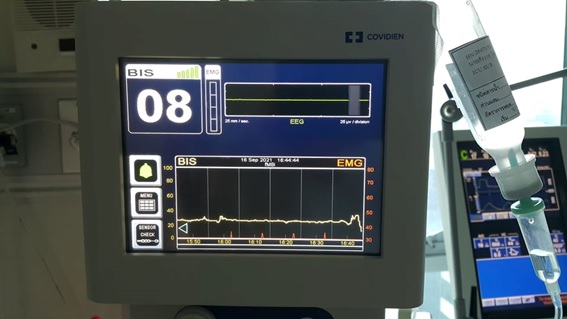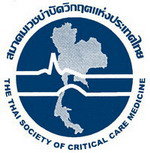รายงานผู้ป่วยการใช้ยาเพื่อลดภาวะสมองบวมที่ควบคุมได้ยากผ่านทางอุปกรณ์ดมยาสลบในหอผู้ป่วยวิกฤตทางศัลยกรรมประสาท
DOI:
https://doi.org/10.54205/ccc.v30.256435คำสำคัญ:
Intractable cerebral edema, Decompressive craniectomy, Barbiturates coma, Inhaled sevoflurane, Anesthetic conserving deviceบทคัดย่อ
Background: Burst suppression are widely used in case of refractory increased intracranial pressure for deep state of brain inactivation. Inhaled sevoflurane via the anesthetic conserving device could be useful for the sedation of patients in the intensive care unit (ICU), but prospective studies have been small study.
Case report: A 53-year-old male patient with confusion, not follow to command and status epilepticus had been hospitalized and diagnosed glioblastoma multiforme at left temporal lobe. By the time initial therapy had begun with dexamethasone and anti-epileptic drug, the symptoms had improved. The patient was performed craniotomy with tumor removal during intra-operative found intractable cerebral edema and changed operation to decompressive craniectomy, in post-operative period after increased dosage of propofol and midazolam to control intracranial pressure, patient developed hypotension, then norepinephrine was titrated to maintain mean arterial pressure more than 65 mmHg and used inhaled sevoflurane to decrease dose propofol for maintain hemodynamics then during 5 day usage inhaled sevoflurane, norepinephrine could wean off and Glasgow coma scale was improve. Follow up brain EEG at 1st week showed no epileptiform discharge, antiepileptic drug could de-escalated and CT scan showed no refractory cerebral edema or hemorrhage. Ventilator was weaned off and the patient was transfer to step down ward.
Conclusion: When managing intractable cerebral edema patient with inhaled sevoflurane showed that lower opioid dose intensity, promote resolving from seizures or status epilepticus, decrease dose of vasopressor to maintain hemodynamics and no adverse events supported the use of inhaled sevoflurane via the anesthetic conserving device in this patient who have clinical need for burst suppression.
Downloads
เอกสารอ้างอิง
McDermott MW, Durity FA, Borozny M, et al. Temporary vessel occlusion and barbiturate protection in cerebral aneurysm surgery. Neurosurgery. 1989;25:54–61; discussion 61–62.
Shapiro HM. Barbiturates in brain ischaemia. Br J Anaesth. 1985;57:82–95.
Spetzler RF, Hadley MN. Protection against cerebral ischemia: the role of barbiturates. Cerebrovasc Brain Metab Rev. 1989;1:212–229.
Drummond JC, Patel PM. Neurosurgical anesthesia. In: Miller RA, Eriksson LI, Fleisher LA, et al, eds. Miller’s Anesthesia. Philadelphia: Elsevier; 2009:2045–2087.
Bendo AA, Kass IS, Hartung J, et al. Anesthesia for neurosurgery. In: Barash PG, Cullen BF, Stoelting RK, eds. Clinical Anesthesia. Philadelphia: LWW; 2006:746–789.
Winer JW, Rosenwasser RH, Jimenez F. Electroencephalographic activity and serum and cerebrospinal fluid pentobarbital levels in determining the therapeutic end point during barbiturate coma. Neurosurgery. 1991;29:739–741.
Riker RR, Fraser GL, Wilkins ML. Comparing the bispectral index and suppression ratio with burst suppression of the electroencephalogram during pentobarbital infusions in adult intensive care patients. Pharmacotherapy. 2003;23:1087–1093.
Eveson, L., Vizcaychipi, M. & Patil, S. Role of bispectral index monitoring and burst suppression in prognostication following out-of-hospital cardiac arrest: a systematic review protocol. Syst Rev 6, 191 (2017).
Niu B, Xiao JY, Fang Y, et al. Sevoflurane-induced isoelectric EEG and burst suppression: differential and antagonistic effect of added nitrous oxide. Anaesthesia. 2017;72(5):570-579.
Purrucker JC, Renzland J, Uhlmann L, Bruckner T, Hacke W, Steiner T, et al. Volatile sedation with sevoflurane in intensive care patients with acute stroke or subarachnoid haemorrhage using AnaConDa®: An observational study. Br J Anaesth 2015;114:934‑43.
Misra S, Koshy T. A review of the practice of sedation with inhalational anaesthetics in the intensive care unit with the AnaConDa(®) device. Indian J Anaesth 2012;56:518‑23.
Meiser A, Laubenthal H. Inhalational anaesthetics in the ICU: Theory and practice of inhalational sedation in the ICU, economics, risk‑benefit. Best Pract Res Clin Anaesthesiol 2005;19:523‑38.
Bösel J, Purrucker JC, Nowak F, Renzland J, Schiller P, Pérez EB, et al. Volatile isoflurane sedation in cerebrovascular intensive care patients using AnaConDa(®): Effects on cerebral oxygenation, circulation, and pressure. Intensive Care Med 2012;38:1955‑64.
Soukup J, Scharff K, Kubosch K, Pohl C, Bomplitz M, Kompardt J.State of the art: sedation concepts with volatile anesthetics in critically Ill patients. J Crit Care 2009;24:535–544.
Ruszkai Z., Bokrétas G.P. and Bartha P.T. 2014. Sevoflurane therapy for life-threatening acute severe asthma : a case report. Can. J. Anesth. 61 : 943-950.
Beck-Schimmer B, Restin T, Muroi C, Roth Z'Graggen B, Keller E, Schläpfer M. Sevoflurane sedation attenuates early cerebral oedema formation through stabilisation of the adherens junction protein beta catenin in a model of subarachnoid haemorrhage: A randomised animal study. Eur J Anaesthesiol. 2020 May;37(5):402-412.
Suzuki H, Fujimoto M, Kawakita F, et al. Tenascin-C in brain injuries and edema after subarachnoid hemorrhage: findings from basic and clinical studies. J Neurosci Res 2018; 98:42–56.
Altay O, Suzuki H, Hasegawa Y, et al. Isoflurane attenuates blood-brain barrier disruption in ipsilateral hemisphere after subarachnoid hemorrhage in mice. Stroke 2012; 43:2513–2516.
Petersen KD, Landsfeldt U, Cold GE, et al. Intracranial pressure and cerebral hemodynamic in patients with cerebral tumors: a randomized prospective study of patients subjected to craniotomy in propofol-fentanyl, isoflurane-fentanyl, or sevoflurane-fentanyl anesthesia. Anesthesiology 2003; 98:329–336.
Bundgaard H, von Oettingen G, Larsen KM, et al. Effects of sevoflurane on intracranial pressure, cerebral blood flow and cerebral metabolism. A doseresponse study in patients subjected to craniotomy for cerebral tumours. Acta Anaesthesiol Scand 1998; 42:621–627.
Artru AA, Lam AM, Johnson JO, et al. Intracranial pressure, middle cerebral artery flow velocity, and plasma inorganic fluoride concentrations in neurosurgical patients receiving sevoflurane or isoflurane. Anesth Analg 1997; 85:587–592.
Bedirli N, Bagriacik EU, Yilmaz G, et al. Sevoflurane exerts brain-protective effects against sepsis-associated encephalopathy and memory impairment through caspase 3/9 and Bax/Bcl signaling pathway in a rat model of sepsis. Journal of International Medical Research. July 2018:2828-2842.
Stetefeld HR, Schaal A, Scheibe F, Nichtweiß J, Lehmann F, Müller M, Gerner ST, Huttner HB, Luger S, Fuhrer H, Bösel J, Schönenberger S, Dimitriadis K, Neumann B, Fuchs K, Fink GR, Malter MP; IGNITE Study Group, with support from the German Neurocritical Care Society (DGNI). Isoflurane in (Super-) Refractory Status Epilepticus: A Multicenter Evaluation. Neurocrit Care. 2021 Dec;35(3):631-639.
Madžar D, Reindl C, Giede-Jeppe A, et al. Impact of timing of continuous intravenous anesthetic drug treatment on outcome in refractory status epilepticus. Crit Care. 2018;22(1):317.
Caronna E, Vilaseca A, Maria Gràcia Gozalo R, et al. Long-term prognosis related to deep sedation in refractory status epilepticus. Acta Neurol Scand. 2020;142(6):555–62.
Chen, S., Lotz, C., Roewer, N. et al. Comparison of volatile anesthetic-induced preconditioning in cardiac and cerebral system: molecular mechanisms and clinical aspects. Eur J Med Res 23, 10 (2018).
Bösel J, Purrucker JC, Nowak F, Renzland J, Schiller P, Pérez EB, Poli S, Brunn B, Hacke W, Steiner T. Volatile isoflurane sedation in cerebrovascular intensive care patients using AnaConDa(®): effects on cerebral oxygenation, circulation, and pressure. Intensive Care Med. 2012 Dec;38(12):1955-64.

ดาวน์โหลด
เผยแพร่แล้ว
รูปแบบการอ้างอิง
ฉบับ
ประเภทบทความ
สัญญาอนุญาต
ลิขสิทธิ์ (c) 2022 สมาคมเวชบำบัดวิกฤตแห่งประเทศไทย

อนุญาตภายใต้เงื่อนไข Creative Commons Attribution-NonCommercial 4.0 International License.




